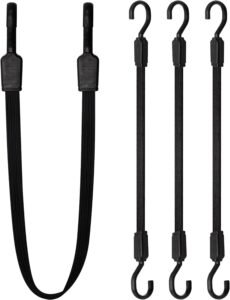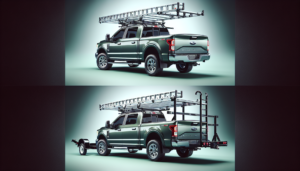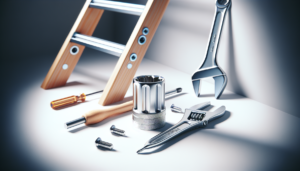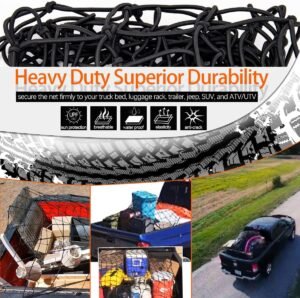If you’ve ever wondered how to safely transport ladders on your vehicle’s ladder rack, look no further. Ensuring the proper securement of ladders is crucial to prevent accidents and potential damage. In this article, we will guide you through the steps to secure your ladders properly on a ladder rack, giving you peace of mind and a worry-free journey. So let’s dive in and discover the best practices to keep your ladders secure and ensure safety during transportation.
Inspect the ladder rack
One of the most important steps in securing ladders properly on a ladder rack is to thoroughly inspect the rack itself. Start by checking for any signs of rust or damage. Rust can weaken the structure of the rack and compromise its overall strength. If you notice any rust, it’s essential to address it before using the rack.
Additionally, visually inspect the rack for any other damage, such as dents or bent parts. These can also affect the stability and strength of the rack, so it’s important to identify and rectify any issues. If you notice any severe damage, consider getting the rack repaired or replaced.
Another crucial aspect of inspecting the ladder rack is ensuring its proper attachment to the vehicle. Check the bolts or clamps that secure the rack to the vehicle and ensure they are tight and secure. Any loose or damaged attachment points can lead to the rack coming loose during transportation, which can be extremely dangerous.
Lastly, verify the stability and strength of the ladder rack. Shake it gently to check for any excessive movement or wobbling. The rack should feel stable and rigid, without any noticeable play. If you detect any instability or weakness, it’s vital to address the issue before loading the ladder onto the rack.
Choose the right ladder rack
Selecting the appropriate ladder rack for your needs is crucial to ensure the safety of both your ladder and the vehicle. Consider the weight capacity of the ladder rack and make sure it can handle the weight of your ladder. Overloading the rack can lead to instability and potentially cause accidents during transportation.
Compatibility with your vehicle is another important factor to consider. Not all ladder racks are designed to fit every vehicle, so it’s essential to check the specifications and ensure it is compatible before making a purchase. Look for racks that are specifically designed for your vehicle make and model to ensure a proper fit.
Evaluate the design and construction of the ladder rack. Look for sturdy materials and quality construction that can withstand the rigors of transportation. Consider features such as adjustable height or width to accommodate different ladders. The design should also allow for easy loading and unloading of the ladder and provide sufficient support and stability during transport.
Prepare the ladder for transport
Before securing the ladder onto the rack, it’s important to prepare it properly to ensure safe transportation. Start by cleaning the ladder and removing any debris or dirt that may have accumulated. This will help prevent any loose particles from creating hazards during transport.
While cleaning, take the opportunity to inspect the ladder for any damage or loose parts. Check for any cracks, bends, or missing rungs that may affect its structural integrity. If you notice any issues, it’s crucial to address them before proceeding. Tighten any loose bolts or screws and replace any damaged parts if necessary.
If your ladder has any movable parts, such as extension mechanisms or hinges, make sure they are secured properly. Fold or lock them in place to prevent them from moving during transportation. This will minimize the risk of any accidents or damage caused by loose parts.
Use proper securing equipment
To ensure that your ladder remains securely attached to the ladder rack during transportation, it’s essential to use the right securing equipment. Choose appropriate tie-down straps or ropes that are designed for securing heavy loads. Look for straps with a high weight capacity and quality construction to ensure they can withstand the forces exerted during transportation.
Consider using ladder clamps or brackets for added stability. These devices are specifically designed to hold ladders securely in place and prevent them from shifting or sliding. Ladder clamps or brackets are typically easy to install and provide an extra layer of security, especially during bumpy rides or sudden stops.
Avoid relying solely on bungee cords or ropes to secure your ladder. While these may be convenient for temporary use, they are not designed to handle the weight or provide the necessary stability for securely transporting ladders.
Secure the ladder rack to the vehicle
Properly attaching the ladder rack to your vehicle is crucial for ensuring the safety of both the ladder and the vehicle itself. Use bolts or clamps to securely attach the ladder rack to the designated mounting points on your vehicle. Follow the manufacturer’s instructions for the specific installation process.
Make sure to tighten all the fasteners properly to ensure a secure connection. Loose bolts or clamps can cause the rack to shift or detach during transportation, posing a significant safety risk. Use appropriate tools, such as a torque wrench, to achieve the recommended tightness for the fasteners.
Ensure a stable and rigid connection between the ladder rack and the vehicle. Avoid any play or movement in the rack by double-checking all the attachment points. A stable connection will minimize the risk of the ladder rack coming loose and potentially causing accidents during transportation.
Position the ladder on the rack
When placing your ladder on the rack, it’s important to follow the proper positioning for optimal safety and stability. Place the ladder horizontally on the rack, aligning it with the support bars of the rack. This ensures that the weight of the ladder is evenly distributed and minimizes the risk of it shifting or falling.
Make sure the ladder does not extend beyond the width of your vehicle. If it protrudes beyond the vehicle’s width, it may pose a hazard to other drivers on the road and increase the risk of accidents. Adjust the ladder’s position on the rack to ensure it remains within the limits of your vehicle.
Use additional support if necessary
Depending on the length and weight of your ladder, it may require additional support to ensure its stability during transportation. Consider using ratchet straps for added stability. Ratchet straps are strong and reliable, and they allow you to tighten the strap securely around the ladder, minimizing any movement during transit.
Using ladder stoppers or tie-downs can also help prevent any movement or shifting of the ladder. These devices, specifically designed for ladders, can be attached to the ladder rack and hold the ladder in place. They provide an extra layer of security, especially when driving on uneven or rough roads.
Avoid overloading the ladder rack with more weight than it can safely handle. Exceeding the weight capacity of the rack can lead to instability and increase the risk of accidents. If your ladder is too heavy for the rack to handle without compromising safety, consider alternative transportation methods or upgrading to a sturdier ladder rack.
Double-check the security
Before hitting the road, it’s crucial to double-check the security of your ladder and ladder rack. Ensure that all the tie-down straps or ropes are tightly secured and properly wrapped around the ladder. Check for any signs of looseness or slippage and make any necessary adjustments.
Confirm that the ladder is stable on the rack and does not wobble. Give it a gentle shake to test its stability. If you notice any excessive movement or instability, reevaluate the securing methods and make the necessary improvements.
Detect any signs of potential issues, such as loose bolts or damaged components, during the final security check. Address these issues immediately to prevent any accidents or further damage during transportation.
Test the setup before transportation
Before starting your journey, conduct a final test of the ladder rack and ladder setup. Shake the ladder rack and ladder to confirm their stability. Pay attention to any unusual noises or movements that may indicate an insecure connection or setup. If you notice anything concerning, make the necessary adjustments or repairs before proceeding.
Testing the setup before transportation allows you to address any potential issues or risks early on, reducing the chances of accidents or damage during your journey. It provides you with the opportunity to make any necessary changes to the securing methods or positioning of the ladder.
Regularly maintain the ladder rack
Maintaining your ladder rack is essential for its longevity and continued safe use. After each use, clean the rack to remove any dirt, debris, or chemicals that may have accumulated during transportation. Use a mild detergent and water solution to clean the rack, and rinse it thoroughly to remove any residue.
While cleaning, inspect the ladder rack for any signs of wear or damage. Check all components, including bolts, clamps, and support bars, for any loose or damaged parts. Repair or replace any damaged components as soon as possible to maintain the integrity and safety of the ladder rack.
Regularly perform maintenance tasks, such as lubricating moving parts or tightening bolts, to keep the ladder rack in optimal condition. Follow the manufacturer’s maintenance guidelines for your specific ladder rack model to ensure proper care and maximize its lifespan.
By following these comprehensive steps and guidelines, you can secure your ladders properly on a ladder rack and ensure their safety during transportation. Remember to always prioritize inspecting the ladder rack, choosing the right equipment, and regularly maintaining the rack for a safe and secure transportation experience.





